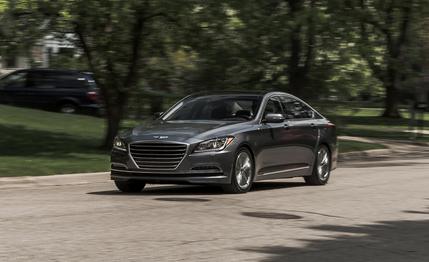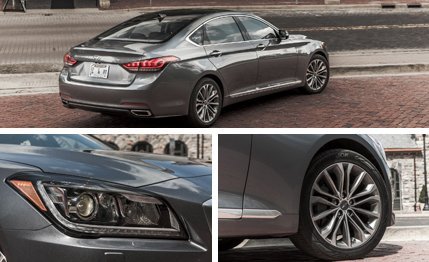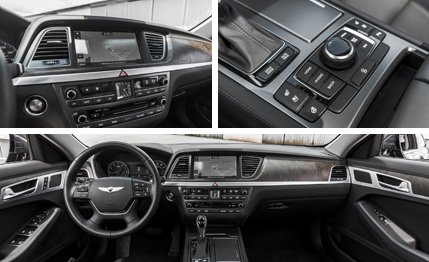
 Instrumented Test
Instrumented Test
When we evaluated Hyundai’s 2015 Genesis V-6 sedan on the battered tarmac around our Michigan headquarters, we noted that surface was perfect for analyzing the Lotus-tuned suspension. As for exploring the foul-weather usefulness of the Genesis’s newly available HTRAC all-wheel-drive system, our environs proved less helpful. Traction-reducing precipitation was nowhere to be found, especially that of the flaky, frozen variety that was all too prevalent last winter. Where’s a polar vortex when you need one?
Like AWD? Hope You Like a V-6, Too
Although we didn’t face any major traction issues during our test of the all-wheel-drive Genesis V-6, we did observe that Hyundai’s HTRAC setup never called attention to itself. This is unlike, for example, the Quattro system in our long-term Audi S7, which binds perceptibly in tight parking-lot maneuvers. Where HTRAC did make a difference, however, was in stifling wheelspin during hard launches.


HTRAC can only be paired with the Genesis’s standard 3.8-liter V-6, which makes 311 horsepower and 293 lb-ft of torque. (The available 5.0-liter V-8 makes 420 horsepower.) An eight-speed automatic transmission with a wide ratio spread helps keep the six on the boil, though, and we managed to hit 60 mph in 6.2 seconds. Top speed is limited to 149 mph. Hyundai’s in-house eight-speed automatic isn’t as unobtrusive or telepathic as the bolt-action ZF-sourced eight-speeds in many BMWs, but the Hyundai gearbox makes up for the occasional flubbed downshift with its overall smoothness.
As we’ve found driving other Genesis models, the sedan’s steering is accurate but numb and the chassis is tuned for resolute understeer. HTRAC exaggerates the feeling of understeer, with our test driver noting it as “excessive” during skidpad testing. Even so, the all-wheel-drive Genesis hung on for a commendable 0.87 g, which turned out to be identical to the grip generated by the rear-wheel-drive model also tested. Even with the added all-wheel-drive hardware, the HTRAC Genesis V-6 managed to feel sprightlier than the Genesis V-8. (On our scales, the HTRAC Genesis V-6 weighed 85 fewer pounds than the rear-drive Genesis V-8—with most of that coming off the front axle.) Braking was only so-so, with the Hyundai hauling itself to a stop from 70 mph in a longish 172 feet.


5-series Size and Features for 3-series Money
During a two-week period in our hands, the Genesis managed a respectable 21 mpg, in spite of its 4516-pound curb weight and our lead feet. Our $52,450 Genesis test car was a popular highway cruiser, what with its comfortable and composed ride, quiet cabin, and full complement of tech and luxury packages. (You can read about what’s standard and what’s included in those options packages here.)
Based on content alone, the second-generation Genesis remains a huge value, especially compared with mid-size luxury sedans from established German players such as the BMW 528i xDrive. With all-wheel drive and the car’s much-improved ride and handling, the Genesis sedan deserves a long look from Snowbelters.